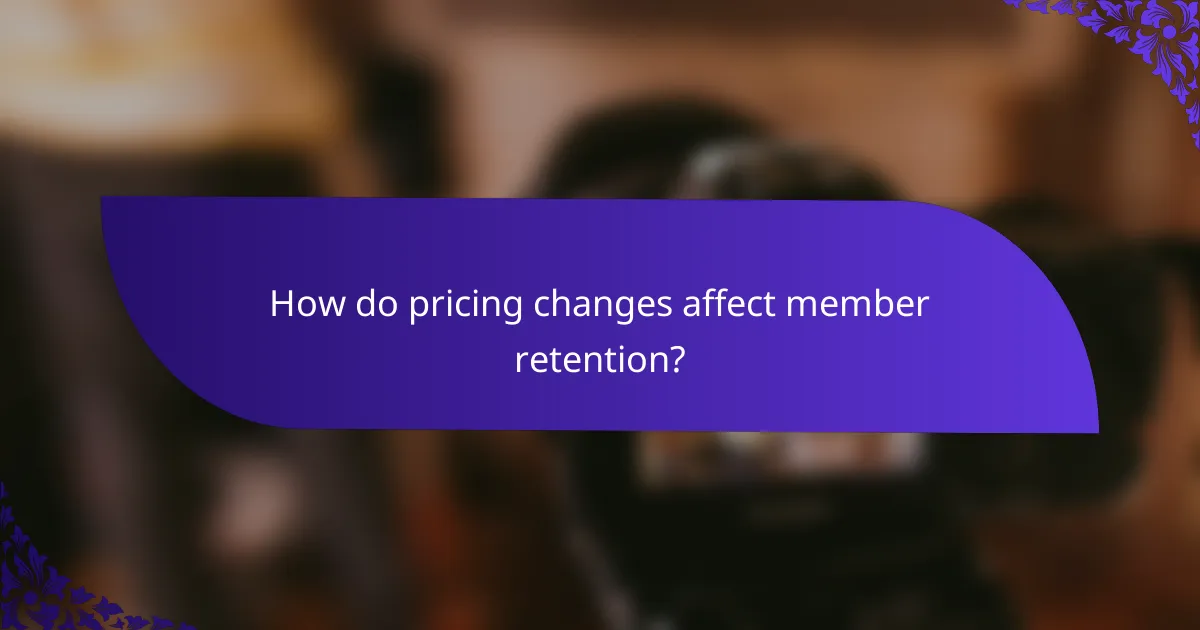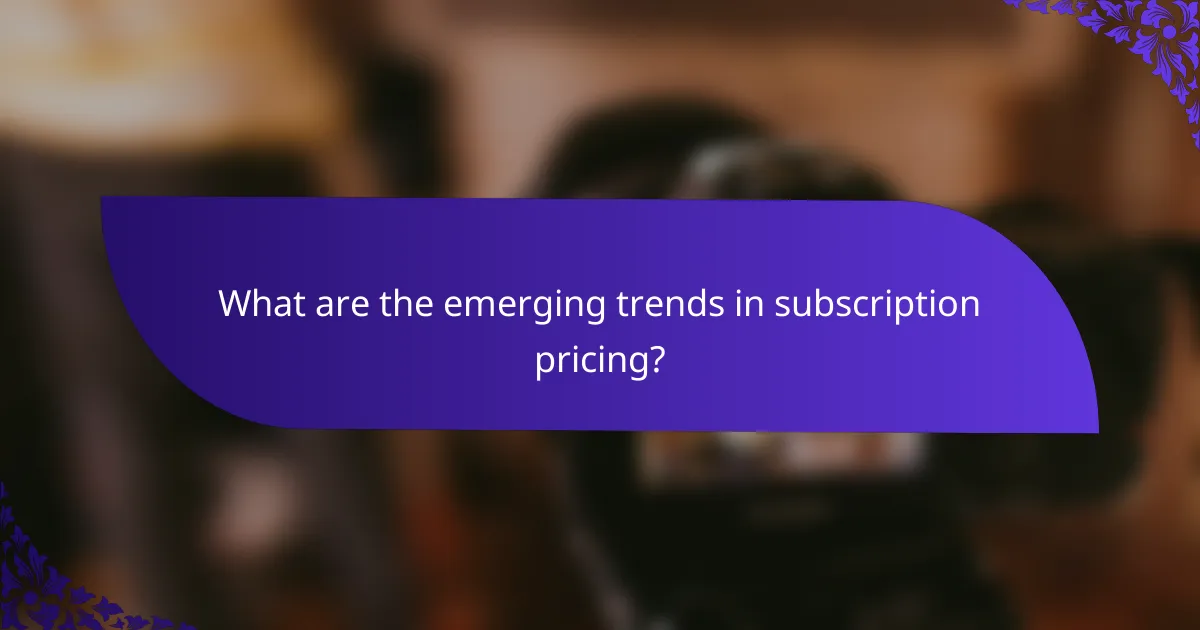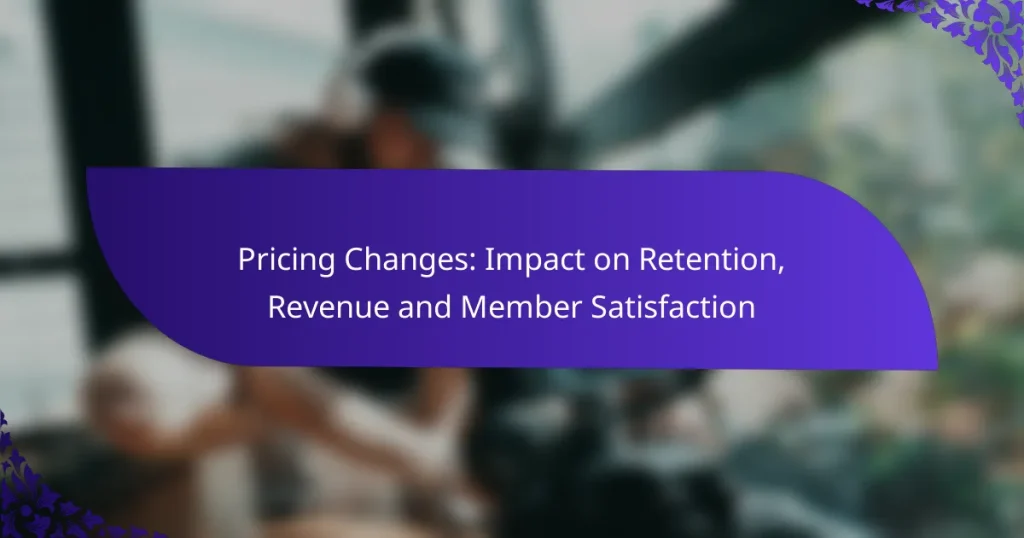Pricing changes play a crucial role in shaping member retention, revenue, and overall satisfaction. When prices are adjusted, members may reassess the value they receive, which can lead to increased churn if they feel the new rates do not align with their expectations. To navigate these challenges, businesses must adopt strategies that enhance perceived value and foster open communication with their members.

How do pricing changes affect member retention?
Pricing changes can significantly impact member retention by influencing how satisfied members feel with their service and whether they perceive value in their subscription. When prices increase, members may reconsider their commitment, leading to higher churn rates if they feel the new pricing does not match the benefits received.
Increased churn rates
When prices rise, many members may choose to cancel their subscriptions, resulting in increased churn rates. This is particularly true if members do not see a corresponding increase in value or service quality. Businesses should monitor churn closely after a price change to understand its impact and adjust strategies accordingly.
To mitigate churn, companies can communicate the reasons for the price increase and highlight any enhancements to the service. Offering temporary discounts or loyalty rewards can also help retain members during this transition.
Impact on loyalty programs
Pricing changes can affect loyalty programs by altering the perceived value of rewards. If members feel that the cost of maintaining their membership outweighs the benefits of the loyalty program, they may disengage. Businesses should evaluate their loyalty offerings in light of any price adjustments to ensure they remain attractive and relevant.
Enhancing loyalty programs with additional benefits or exclusive offers can help counteract negative perceptions. Regularly soliciting member feedback on loyalty programs can also provide insights into how to improve satisfaction and retention.
Case study: Netflix price hikes
Netflix has implemented several price hikes over the years, which have led to mixed reactions from its subscriber base. Initially, these increases resulted in a spike in cancellations, particularly among price-sensitive members. However, Netflix has successfully retained many users by continually investing in original content and improving user experience.
This case illustrates the importance of balancing price increases with perceived value. By enhancing content offerings and maintaining high-quality service, Netflix managed to stabilize its subscriber base despite higher prices. Companies can learn from this approach by ensuring that any pricing changes are accompanied by tangible improvements in service or product quality.

What strategies can mitigate revenue loss from pricing changes?
To mitigate revenue loss from pricing changes, businesses can implement strategies that enhance perceived value, adjust pricing structures, and actively engage with members for feedback. These approaches help maintain customer satisfaction and loyalty while ensuring revenue stability.
Value communication tactics
Effectively communicating the value of your offerings is crucial when implementing pricing changes. Highlight the benefits and features that justify the new prices, such as improved services or added features. Use clear messaging across all channels to reinforce the value proposition.
Consider utilizing testimonials, case studies, or data that showcase the positive impact of your product or service on users. This can help reassure members that the price increase is warranted and beneficial.
Tiered pricing models
Implementing tiered pricing models allows customers to choose from different levels of service or product features at varying price points. This flexibility can cater to a broader audience, from budget-conscious members to those willing to pay more for premium offerings.
For example, a software company might offer a basic plan at a lower price, a standard plan with additional features, and a premium plan that includes exclusive benefits. This approach can help retain customers who may be sensitive to price increases by providing them with options that fit their budget.
Member feedback integration
Integrating member feedback into pricing strategies can significantly enhance retention and satisfaction. Regularly solicit input through surveys, focus groups, or direct conversations to understand how pricing changes affect customer perceptions and behaviors.
Acting on feedback can lead to adjustments that better meet member expectations, such as offering discounts for long-term members or introducing loyalty programs. This responsiveness can foster trust and loyalty, reducing the likelihood of churn following a price increase.

How do pricing changes influence revenue generation?
Pricing changes can significantly impact revenue generation by either boosting short-term income or affecting long-term customer loyalty. Adjustments in pricing strategies need careful consideration to balance immediate financial gains with sustainable growth.
Short-term revenue spikes
Implementing a price increase can lead to immediate revenue spikes, especially if the product or service has inelastic demand. Customers may rush to purchase before the price rises, resulting in a temporary surge in sales. However, this approach can backfire if customers feel the increase is unjustified.
To maximize short-term gains, consider promotional strategies that highlight the value of the offering. Limited-time offers or exclusive access can create urgency, encouraging customers to buy before the price changes take effect.
Long-term financial sustainability
While short-term revenue spikes are beneficial, long-term financial sustainability requires a focus on customer retention and satisfaction. Frequent pricing changes can lead to customer dissatisfaction, potentially harming loyalty and reducing repeat purchases. It’s essential to ensure that any price adjustments align with perceived value.
Establishing a transparent pricing strategy and communicating the reasons for changes can help maintain customer trust. Regularly assessing market conditions and competitor pricing can also inform sustainable pricing practices that support ongoing revenue generation.
Examples from Amazon Prime
Amazon Prime’s pricing strategy illustrates the balance between short-term revenue and long-term value. When Amazon raised its subscription fee, it experienced an initial surge in sign-ups as customers rushed to lock in the lower rate. However, the company also focused on enhancing the service, adding benefits like faster shipping and exclusive content.
This approach not only justified the price increase but also fostered long-term loyalty among members. Amazon’s ability to continually add value helps mitigate potential backlash from price hikes, demonstrating how effective pricing changes can drive both immediate revenue and sustained customer satisfaction.

What role does member satisfaction play in pricing adjustments?
Member satisfaction is crucial in pricing adjustments as it directly influences retention, revenue, and overall engagement. When members feel valued and satisfied, they are more likely to accept price changes and remain loyal to the service.
Correlation with NPS scores
Net Promoter Score (NPS) is a key metric that reflects member satisfaction and loyalty. A higher NPS often correlates with a greater willingness to accept price increases, as satisfied members are more likely to recommend the service to others. Conversely, a low NPS may indicate dissatisfaction, suggesting that price changes could lead to increased churn.
To effectively leverage NPS, regularly survey members and track changes over time. This data can guide pricing strategies, ensuring adjustments align with member sentiment.
Feedback mechanisms
Implementing robust feedback mechanisms is essential for understanding member satisfaction regarding pricing. Surveys, focus groups, and direct feedback channels allow members to express their views on pricing changes. This input can highlight potential issues and areas for improvement.
Consider using a combination of quantitative and qualitative feedback to gain a comprehensive view. For example, a survey might reveal that 70% of members are comfortable with a small price increase, while open-ended responses can provide insights into specific concerns or suggestions.

What frameworks help assess pricing impact on subscriptions?
To evaluate the impact of pricing changes on subscriptions, frameworks such as retention metrics analysis and revenue forecasting models are essential. These tools help organizations understand how pricing adjustments affect customer loyalty, revenue generation, and overall member satisfaction.
Retention metrics analysis
Retention metrics analysis focuses on measuring how well a subscription service retains its customers over time. Key metrics include churn rate, customer lifetime value (CLV), and net promoter score (NPS). Monitoring these indicators can reveal how pricing changes influence customer loyalty and satisfaction.
For instance, a significant increase in churn rate following a price hike may indicate that customers perceive the new pricing as unfavorable. Regularly analyzing these metrics allows businesses to adjust their pricing strategies proactively to enhance retention.
Revenue forecasting models
Revenue forecasting models project future income based on historical data and market trends. These models consider factors such as pricing changes, customer acquisition rates, and economic conditions. Utilizing these forecasts helps organizations anticipate the financial impact of pricing adjustments.
For example, a subscription service might use a model that predicts a 10-15% revenue increase if a price increase leads to a slight drop in subscriber numbers. By regularly updating these forecasts with actual performance data, businesses can refine their pricing strategies to optimize revenue.

How can companies adapt to market trends in pricing?
Companies can adapt to market trends in pricing by implementing flexible strategies that respond to consumer behavior and competitive dynamics. This involves regularly assessing pricing models and adjusting them based on market conditions, customer feedback, and competitor actions.
Dynamic pricing strategies
Dynamic pricing strategies allow companies to adjust prices in real-time based on demand, competition, and other market factors. This approach can maximize revenue by capitalizing on peak demand periods while remaining competitive during slower times.
For example, airlines and hotels often use dynamic pricing to change rates based on booking patterns, seasonality, and special events. Companies should consider using data analytics tools to monitor trends and automate pricing adjustments effectively.
However, businesses must be cautious not to alienate customers with frequent price changes. Establishing clear communication about pricing policies can help maintain trust and satisfaction among members.
Competitor analysis
Competitor analysis involves evaluating the pricing strategies of similar businesses to identify market positioning and potential areas for adjustment. By understanding how competitors price their products or services, companies can make informed decisions about their own pricing structures.
Regularly benchmarking against competitors can reveal pricing trends and consumer preferences. Companies should consider using tools that track competitor prices and promotions, allowing for timely adjustments that enhance competitiveness.
It’s essential to balance competitiveness with profitability. Companies should avoid engaging in price wars that could erode margins and instead focus on value differentiation to attract and retain customers.

What are the emerging trends in subscription pricing?
Emerging trends in subscription pricing focus on flexibility and personalization to enhance customer retention, revenue, and satisfaction. Businesses are increasingly adopting innovative pricing strategies that cater to individual preferences and usage patterns.
Personalized pricing models
Personalized pricing models tailor subscription costs based on user behavior, preferences, and demographics. This approach allows companies to offer different prices to different customers, optimizing revenue while enhancing user satisfaction.
For instance, streaming services may charge varying rates based on viewing habits or offer discounts to long-term subscribers. This strategy can increase retention by making customers feel valued and understood.
When implementing personalized pricing, consider factors such as customer segmentation and data privacy regulations. Avoid pitfalls like price discrimination that could alienate certain user groups. Instead, focus on transparent communication about how pricing is determined to maintain trust and satisfaction.


